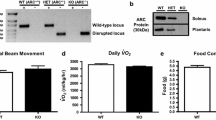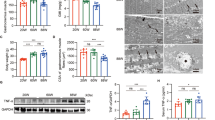Abstract
Tumor necrosis factor-alpha (TNF-α) is elevated in the serum as a result of aging and it promotes pro-apoptotic signaling upon binding to the type I TNF receptor. It is not known if activation of this apoptotic pathway contributes to the well-documented age-associated decline in muscle mass (i.e. sarcopenia). We tested the hypothesis that skeletal muscles from aged rodents would exhibit elevations in markers involved in the extrinsic apoptotic pathway when compared to muscles from young adult rodents, thereby contributing to an increased incidence of nuclear apoptosis in these muscles. The plantaris (fast) and soleus (slow) muscles were studied in young adult (5–7 mo, n=8) and aged (33 mo, n=8) Fischer344 × Brown Norway rats. Muscles from aged rats were significantly smaller while exhibiting a greater incidence of apoptosis. Furthermore, muscles from aged rats had higher type I TNF receptor and Fas associated death domain protein (FADD) mRNA, protein contents for FADD, BCL-2 Interacting Domain (Bid), FLICE-inhibitory protein (FLIP), and enzymatic activities of caspase-8 and caspase-3 than muscles from young adult rats. Significant correlations were observed in the plantaris muscle between caspase activity and muscle weight and the apoptotic index, while similar relationships were not found in the soleus. These data demonstrate that pro-apoptotic signaling downstream of the TNF receptor is active in aged muscles. Furthermore, our data extend the previous demonstration that type II fibers are preferentially affected by aging and support the hypothesis that type II fiber containing skeletal muscles may be more susceptible to muscle mass loses via the extrinsic apoptotic pathway.
Similar content being viewed by others
References
Ansved T, Larsson L (1989) Effects of ageing on enzyme-histochemical, morphometrical and contractile properties of the soleus muscle in the rat. J Neurol Sci 93:105–24
Larsson L, Grimby G, Karlsson J (1979) Muscle strength and speed of movement in relation to age and muscle morphology. J Appl Physiol 46:451–56
Larsson L, Sjodin B, Karlsson J (1978) Histochemical and biochemical changes in human skeletal muscle with age in sedentary males, age 22–5 years. Acta Physiol Scand 103:31–9
Tenover JL (1997) Testosterone and the aging male. J Androl 18:103–06
Tenover JS, Matsumoto AM, Plymate SR, Bremner WJ (1987) The effects of aging in normal men on bioavailable testosterone and luteinizing hormone secretion: response to clomiphene citrate. J Clin Endocrinol Metab 65:1118–126
Bruunsgaard H (2002) Effects of tumor necrosis factor-alpha and interleukin-6 in elderly populations. Eur Cytokine Netw 13:389–91
Bruunsgaard H, Andersen-Ranberg K, Hjelmborg JB, Pedersen BK, Jeune B (2003) Elevated levels of tumor necrosis factor alpha and mortality in centenarians. Am J Med 115:278–83
Bruunsgaard H, Andersen-Ranberg K, Jeune B, Pedersen AN, Skinhoj P, Pedersen BK (1999) A high plasma concentration of TNF-alpha is associated with dementia in centenarians. J Gerontol A Biol Sci Med Sci 54:M357–M364
Bruunsgaard H, Ladelund S, Pedersen AN, Schroll M, Jorgensen T, Pedersen BK (2003) Predicting death from tumour necrosis factor-alpha and interleukin-6 in 80-year-old people. Clin Exp Immunol 132:24–1
Bruunsgaard H, Pedersen M, Pedersen BK (2001) Aging and proinflammatory cytokines. Curr Opin Hematol 8:131–36
Pedersen M, Bruunsgaard H, Weis N et al (2003) Circulating levels of TNF-alpha and IL-6-relation to truncal fat mass and muscle mass in healthy elderly individuals and in patients with type-2 diabetes. Mech Ageing Dev 124:495–02
Sandmand M, Bruunsgaard H, Kemp K, Andersen-Ranberg K, Schroll M, Jeune B (2003) High circulating levels of tumor necrosis factor-alpha in centenarians are not associated with increased production in T lymphocytes. Gerontology 49:155–60
Visser M, Pahor M, Taaffe DR et al (2002) Relationship of interleukin-6 and tumor necrosis factor-alpha with muscle mass and muscle strength in elderly men and women: the Health ABC Study. J Gerontol A Biol Sci Med Sci 57:M326–M332
Dirks A, Leeuwenburgh C (2002) Apoptosis in skeletal muscle with aging. Am J Physiol Regul Integr Comp Physiol 282:R519–R527
Leeuwenburgh C, Gurley CM, Strotman BA, Dupont-Versteegden EE (2005) Age-related differences in apoptosis with disuse atrophy in soleus muscle. Am J Physiol Regul Integr Comp Physiol 288:R1288–R1296
Siu PM, Alway SE (2005) Mitochondria-associated apoptotic signalling in denervated rat skeletal muscle. J Physiol 565:309–23
Siu PM, Pistilli EE, Alway SE (2005) Apoptotic responses to hindlimb suspension in gastrocnemius muscles from young adult and aged rats. Am J Physiol Regul Integr Comp Physiol
Siu PM, Pistilli EE, Butler DC, Alway SE (2005) Aging influences cellular and molecular responses of apoptosis to skeletal muscle unloading. Am J Physiol Cell Physiol 288:C338–C349
Pistilli EE, Siu PM, Alway SE (2006) Molecular regulation of apoptosis in fast plantaris muscles of aged rats. J Gerontol A Biol Sci Med Sci 61:245–55
Dalla LL, Ravara B, Volterrani M et al (2004) Beneficial effects of GH/IGF-1 on skeletal muscle atrophy and function in experimental heart failure. Am J Physiol Cell Physiol 286:C138–C144
Siu PM, Alway SE (2005) Id2 and p53 participate in apoptosis during unloading-induced muscle atrophy. Am J Physiol Cell Physiol 288:C1058–C1073
Allen DL, Linderman JK, Roy RR et al (1997) Apoptosis: a mechanism contributing to remodeling of skeletal muscle in response to hindlimb unweighting. Am J Physiol 273:C579–C587
Hikida RS, Van Nostran S, Murray JD, Staron RS, Gordon SE, Kraemer WJ (1997) Myonuclear loss in atrophied soleus muscle fibers. Anat Rec 247:350–54
Adams V, Gielen S, Hambrecht R, Schuler G (2001) Apoptosis in skeletal muscle. Front Biosci 6:D1–D11
Phillips T, Leeuwenburgh C (2005) Muscle fiber specific apoptosis and TNF-alpha signaling in sarcopenia are attenuated by life-long calorie restriction. FASEB J 19:668–70
Sprick MR, Walczak H (2004) The interplay between the Bcl-2 family and death receptor-mediated apoptosis. Biochim Biophys Acta 1644:125–32
Winer J, Jung CK, Shackel I, Williams PM (1999) Development and validation of real-time quantitative reverse transcriptase-polymerase chain reaction for monitoring gene expression in cardiac myocytes in vitro. Anal Biochem 270:41–9
Nieman DC, Davis JM, Henson DA et al (2003) Carbohydrate ingestion influences skeletal muscle cytokine mRNA and plasma cytokine levels after a 3-h run. J Appl Physiol 94:1917–925
Nieman DC, Davis JM, Brown VA et al (2004) Influence of carbohydrate ingestion on immune changes after 2 h of intensive resistance training. J Appl Physiol 96:1292–298
Rothermel B, Vega RB, Yang J, Wu H, Bassel-Duby R, Williams RS (2000). A protein encoded within the Down syndrome critical region is enriched in striated muscles and inhibits calcineurin signaling. J Biol Chem 275:8719–725
Ng PW, Porter AG, Janicke RU (1999) Molecular cloning and characterization of two novel pro-apoptotic isoforms of caspase-10. J Biol Chem 274:10301–0308
Forsey RJ, Thompson JM, Ernerudh J et al (2003) Plasma cytokine profiles in elderly humans. Mech Ageing Dev 124:487–93
Garcia-Martinez C, Llovera M, Agell N, Lopez-Soriano FJ, Argiles JM (1995) Ubiquitin gene expression in skeletal muscle is increased during sepsis: involvement of TNF-alpha but not IL-1. Biochem Biophys Res Commun 217:839–44
Garcia-Martinez C, Agell N, Llovera M, Lopez-Soriano FJ, Argiles JM (1993) Tumour necrosis factor-alpha increases the ubiquitinization of rat skeletal muscle proteins. FEBS Lett 323:211–14
Llovera M, Lopez-Soriano FJ, Argiles JM (1993) Effects of tumor necrosis factor-alpha on muscle-protein turnover in female Wistar rats. J Natl Cancer Inst 85:1334–339
Llovera M, Garcia-Martinez C, Agell N, Marzabal M, Lopez-Soriano FJ, Argiles JM (1994) Ubiquitin gene expression is increased in skeletal muscle of tumour-bearing rats. FEBS Lett 338:311–18
Carbo N, Busquets S, van Royen M, Alvarez B, Lopez-Soriano FJ, Argiles JM (2002) TNF-alpha is involved in activating DNA fragmentation in skeletal muscle. Br J Cancer 86:1012–016
Garcia-Martinez C, Lopez-Soriano FJ, Argiles JM (1993) Acute treatment with tumour necrosis factor-alpha induces changes in protein metabolism in rat skeletal muscle. Mol Cell Biochem 125:11–8
Foulstone EJ, Meadows KA, Holly JM, Stewart CE (2001) Insulin-like growth factors (IGF-I and IGF-II) inhibit C2 skeletal myoblast differentiation and enhance TNF alpha-induced apoptosis. J Cell Physiol 189:207–15
Meadows KA, Holly JM, Stewart CE (2000) Tumor necrosis factor-alpha-induced apoptosis is associated with suppression of insulin-like growth factor binding protein-5 secretion in differentiating murine skeletal myoblasts. J Cell Physiol 183:330–37
Stewart CE, Newcomb PV, Holly JM (2004) Multifaceted roles of TNF-alpha in myoblast destruction: a multitude of signal transduction pathways. J Cell Physiol 198:237–47
Dirks AJ, Leeuwenburgh C (2005) The role of apoptosis in age-related skeletal muscle atrophy. Sports Med 35:473–83
Leeuwenburgh C (2003) Role of apoptosis in sarcopenia. J Gerontol A Biol Sci Med Sci 58:999–001
Dupont-Versteegden EE (2005) Apoptosis in muscle atrophy: relevance to sarcopenia. Exp Gerontol 40:473–81
Hunter RB, Stevenson E, Koncarevic A, Mitchell-Felton H, Essig DA, Kandarian SC (2002) Activation of an alternative NF-kappaB pathway in skeletal muscle during disuse atrophy. FASEB J 16:529–38
Hashimoto M, Nakajima-Shimada J, Aoki T (2005) Trypanosoma cruzi posttranscriptionally up-regulates and exploits cellular FLIP for inhibition of death-inducing signal. Mol Biol Cell 16:3521–528
Suhara T, Mano T, Oliveira BE, Walsh K (2001) Phosphatidylinositol 3-kinase/Akt signaling controls endothelial cell sensitivity to Fas-mediated apoptosis via regulation of FLICE-inhibitory protein (FLIP). Circ Res 89:13–9
Clarke P, Debiasi RL, Meintzer SM, Robinson BA, Tyler KL (2005) Inhibition of NF-kappa B activity and cFLIP expression contribute to viral-induced apoptosis. Apoptosis 10:513–24
Nagaraju K, Casciola-Rosen L, Rosen A et al (2000) The inhibition of apoptosis in myositis and in normal muscle cells. J Immunol 164:5459–465
Doherty TJ, Vandervoort AA, Brown WF (1993) Effects of ageing on the motor unit: a brief review. Can J Appl Physiol 18:331–58
Doherty TJ (2003) Invited review: aging and sarcopenia. J Appl Physiol 95:1717–727
Chen KD, Alway SE (2001) Clenbuterol reduces soleus muscle fatigue during disuse in aged rats. Muscle Nerve 24:211–22
Chen KD, Alway SE (2000) A physiological level of clenbuterol does not prevent atrophy or loss of force in skeletal muscle of old rats. J Appl Physiol 89:606–12
Degens H, Alway SE (2003) Skeletal muscle function and hypertrophy are diminished in old age. Muscle Nerve 27:339–47
Alway SE, Lowe DA, Chen KD (2001) The effects of age and hindlimb supension on the levels of expression of the myogenic regulatory factors MyoD and myogenin in rat fast and slow skeletal muscles. Exp Physiol 86:509–17
Alloatti G, Penna C, Mariano F, Camussi G (2000) Role of NO and PAF in the impairment of skeletal muscle contractility induced by TNF-alpha. Am J Physiol Regul Integr Comp Physiol 279:R2156–R2163
Tang D, Lahti JM, Kidd VJ (2000) Caspase-8 activation and bid cleavage contribute to MCF7 cellular execution in a caspase-3-dependent manner during staurosporine-mediated apoptosis. J Biol Chem 275:9303–307
Grinberg M, Schwarz M, Zaltsman Y et al (2005) Mitochondrial carrier homolog 2 is a target of tBID in cells signaled to die by tumor necrosis factor alpha. Mol Cell Biol 25:4579–590
Johnson CR, Jarvis WD (2004) Caspase-9 regulation: an update. Apoptosis 9:423–27
Scaffidi C, Fulda S, Srinivasan A et al (1998) Two CD95 (APO-1/Fas) signaling pathways. EMBO J 17:1675–687
Author information
Authors and Affiliations
Corresponding author
Rights and permissions
About this article
Cite this article
Pistilli, E.E., Jackson, J.R. & Alway, S.E. Death receptor-associated pro-apoptotic signaling in aged skeletal muscle. Apoptosis 11, 2115–2126 (2006). https://doi.org/10.1007/s10495-006-0194-6
Published:
Issue Date:
DOI: https://doi.org/10.1007/s10495-006-0194-6




